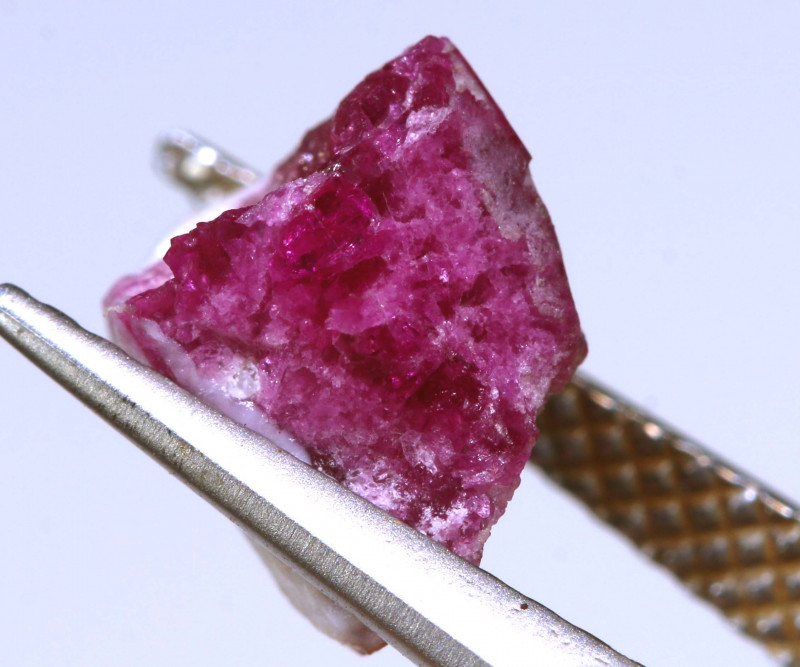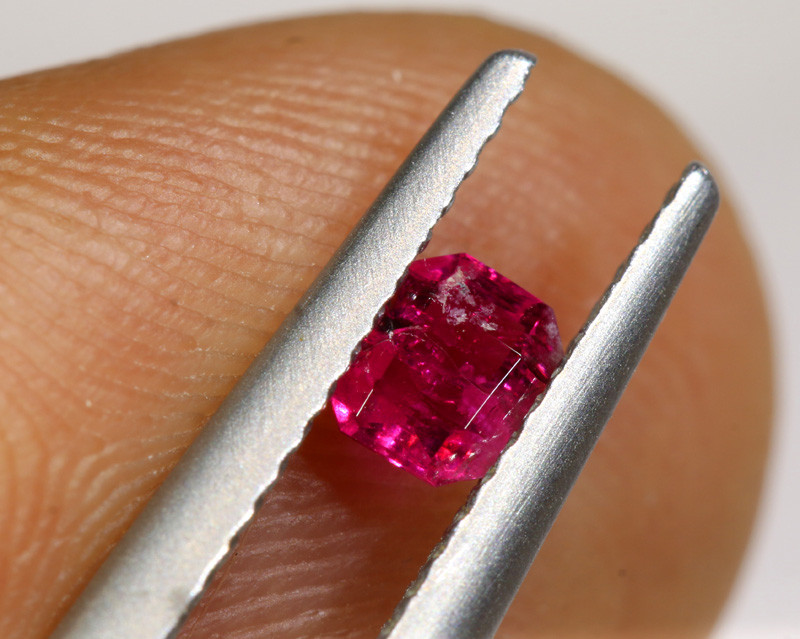Red Beryl Gemstone: Properties, Meanings, Value & More
 Red beryl, formerly called “bixbite,” is a red to purplish-red variety of the gemstone beryl. It’s known for being one of the rarest minerals on Earth, with prices to match.
Red beryl, formerly called “bixbite,” is a red to purplish-red variety of the gemstone beryl. It’s known for being one of the rarest minerals on Earth, with prices to match.
If you’ve ever wondered: what color beryl is most valuable? The answer is red beryl.
It’s difficult to understate just how rare red beryl is, but we’ll try to put it in perspective.
First, is red beryl the rarest gemstone? Some sources say so. In 2006, the Jewelers Association named it the rarest gemstone on Earth, beating out benitoite.
Red beryl is 100-times rarer than emerald and worth 1,000-times more than gold. One red beryl crystal is found for every 150,000 diamonds, and a 2-carat red beryl gemstone is as rare as a 40-carat diamond.
This guide will discuss red beryl’s properties, meanings, prices, history, and more!

About Red Beryl Stone
Red beryl is a semi-precious gemstone, though it’s sometimes marketed with names referencing the precious gemstone emerald, another beryl variety. Some of red beryl’s nicknames or trade names include:
Red emerald
Scarlet emerald
Raspberyl (also used for pezzottaite)
The stone’s similar appearance to ruby can make it a July birthstone substitute. Beryl gems are zodiac stones for Scorpio and Sagittarius.
Red Beryl Specifications & Characteristics
As a beryl mineral, red beryl has the formula Be3Al2Si6O18. Manganese impurities impart the characteristic red to pink hues. Other common impurities include caesium, titanium, zinc, tin, lithium, rubidium, boron, zirconium, niobium, and lead.
Crystals are usually short and flat, though they’re occasionally elongated and barrel-shaped.
How do you identify red beryl? Be sure it’s inert to UV fluorescence and shows absorption spectrum bands at 4250, 4800, 5300, and 5600-5800 nm.
Red beryl’s mineral properties:
Mohs hardness: 7.5-8
Color: Shades of red including pink, purplish-red, and orange-red
Crystal structure: Hexagonal
Luster: Vitreous (glassy)
Transparency: Transparent to translucent
Refractive index: 1.567-1.572
Density: 2.66-2.70
Cleavage: Indistinct/imperfect on [0001]
Fracture: Conchoidal, subconchoidal, or uneven/irregular
Streak: White
Luminescence: None
Pleochroism: Present & moderate to strong - purplish-red to orange-red
Birefringence: 0.004-0.008
Dispersion: 0.014 (low)
 Pictured above: Pezzottaite
Pictured above: Pezzottaite
Red Beryl vs. Similar Gemstones
Red beryl may be confused with other gemstones.
Red Beryl vs Ruby
Is red beryl the same as ruby? Nope! Though similar in appearance, ruby is a corundum variety with a higher Mohs hardness ranking.
Red Beryl vs Pezzottaite
Pezzottaite can be harder to distinguish, as it was initially believed to be a red beryl. However, pezzottaite is a caesium analog of beryl, not a beryl variety.
The major differences between the two are pezzottaite’s higher refractive index (1.598-1.620) and higher density (2.90-3.14).
Red Beryl Meaning & History
Beryl stones symbolize wisdom, resilience, and healing. Ancient Greeks would drink water containing beryl stones to treat kidney stones and bladder problems.
Red beryl individually symbolizes creativity, purity, and achievement.
History
Red beryl was first discovered in 1904 by American mineralogist Maynard Bixby in the Wah Wah mountains of Utah, USA. American geochemist W.F. Hillebrand officially identified it as a new beryl in 1905.
Alfred Eppler named the mineral “bixbite” in 1912 to honor Bixby. However, “bixbite” is no longer used, as it’s easily confused with bixbyite, another mineral discovered by Bixby in 1897.
In 2002, a new gem was discovered in Madagascar that seemed to be a raspberry red beryl variety. It was named pezzottaite after Italian mineralogist Dr. Federico Pezzotta, who was one of the first to examine the mineral. However, further examination showed that pezzottaite was not a true beryl variety but still belonged in the larger beryl group.
Since 2002, pezzottaite has also been found in Afghanistan, but it remains on-par with red beryl in terms of extreme rarity.

Red Beryl Healing Properties
As a healing stone, red beryl carries the properties of its color and gemstone family. Red gemstones like this are great root or heart chakra stones. Beryl stones have specific physical and emotional healing properties.
Physical Healing
Physically, beryl gems like red beryl are said to help with:
Stomach pain
Heart issues
Spine alignment
Kidney stones
Metabolism
Emotional Healing
Emotionally, red beryl can help promote:
Self-confidence
Charisma
Motivation
Honesty
Memory
Some believe beryl stones help you find items you lost.

Red Beryl Gemstone Properties
Red beryl’s price depends on standard properties: color, clarity, cut, carat weight, and treatments. However, virtually any quality of red beryl will be desirable given the stone’s rarity. In fact, under 10,000 red beryl gemstones are cut annually, and over 95 percent of these are used as small accent stones.
Color
Red beryl’s color can range in shades of pink to red, with potential yellow or purple undertones. The most valuable color is pure raspberry pink to somewhat purplish-red.
The cause of red beryl’s color is a combination of manganese, iron, chromium, and calcium impurities. The color is stable up to 1,830 °F (1,000 °C).
Cut
High-quality, raw red beryl crystals are often kept by collectors and not faceted. Given the scarcity of material, the quality of the cut is less important than maximizing the rough used in the cut, so many faceted red beryls display windowing or bad proportions.
Clarity
Like emerald, red beryl has Type III colored gemstone clarity, meaning visible inclusions are almost always present. The best stones will be only slightly included, but this is rare.
Types of inclusions in red beryl include:
Negative crystals
Long, hollow tubes
Chrysanthemums (metallic, flat, and snowflake-shaped)
Feathers
Fractures (healed & unhealed)
Growth banding
Two-phase inclusions
Minerals that may be included in red beryl include quartz, feldspar, hematite, and bixbyite.
Carat Weight & Size
Red beryl’s price per carat will significantly increase with higher carat weights. Most faceted red beryls will be under 1 carat.
The largest red beryl crystals are only around 0.79 in (2 cm) by 2 in (5 cm). Most are under 0.39 in (1 cm) long. Currently, the largest faceted red beryl weighs 8 carats and the largest known red beryl crystal (uncut) weighs 54 carats.
Treatments & Synthetics
Red beryl is rarely treated, though some specimens have undergone fracture or cavity filling.
The Institute of Crystallography in Russia has manufactured and sold synthetic red beryl gems since the 1990s. These gems have identifiable features such as:
Tabular crystals
Internal growth zoning with chevron & subparallel or slightly wavy appearance
Sharp absorption bands at 530, 545, 560, and 590 nm
Presence of cobalt and nickel peaks under ED-XRF spectrometer
Sellers can also create imitation red beryls from dyed glass or other gemstones.

Red Beryl Formation & Sources
Red beryl’s formation is unique from other beryls in that it forms in volcanic, topaz-bearing rhyolite. The conditions are usually low-pressure and high-temperature.
The process starts with rhyolite lava erupting from volcanic vents. The lava cools, creating cracks where beryllium-rich gasses escape. The gasses combine and react with oxidized surface water containing silica, alkali feldspar, and iron-manganese oxides, forming red beryl crystals.
The initial eruption occurred approximately 6 to 7 million years ago.
Part of red beryl’s rarity is due to the rarity of manganese, its coloring agent.
Mining Locations
Where is red beryl found? Red beryl has only been found in a few locations in Utah and New Mexico, USA, with the Wah Wah Mountains of Utah being the primary source.
Now, how much is a red beryl worth?

Red Beryl Price & Value
Red beryl can range from a few hundred dollars to over $20,000. Why is red beryl so expensive? It comes down to its extreme rarity and desirability among collectors.
The price per gram of red beryl gemstones (faceted) weighing below 1 carat is generally $8,000 to $120,000 (or $1,600 to $24,000 per carat). Faceted red beryls over 1 carat are $10,000 to $250,000 per gram (or $2,000 to $50,000 per carat).
You may find some available for as low as $500 to $2,500 per carat.
Is red beryl a good investment? Absolutely! Rare gems tend to only increase in value.
If natural red beryl is out of your price range, synthetic options and jewelry like a synthetic red beryl ring prices are much more affordable, starting at $3 per carat for faceted gems.
Red Beryl Care and Maintenance
Proper gemstone care starts in the store. Despite their hardness, red beryls tend to have lots of inclusions, making them weaker. We strongly recommend protective settings, especially for a red beryl ring.
Only clean red beryl gems with warm water, mild soap, and a soft brush. Store separately from other gems.

Ready to Radiate in Red Beryl?
Red beryl’s extreme rarity matches its beautiful coloring and romantic allure. Luckily, synthetic red beryl for sale makes red beryl gemstones available to more than just investors and collectors, so there’s sure to be a red beryl gem for you!
Was this article helpful?
Ross Sedawie
- Written - 13th Mar 2023
- Edited - 1st Aug 2023
















